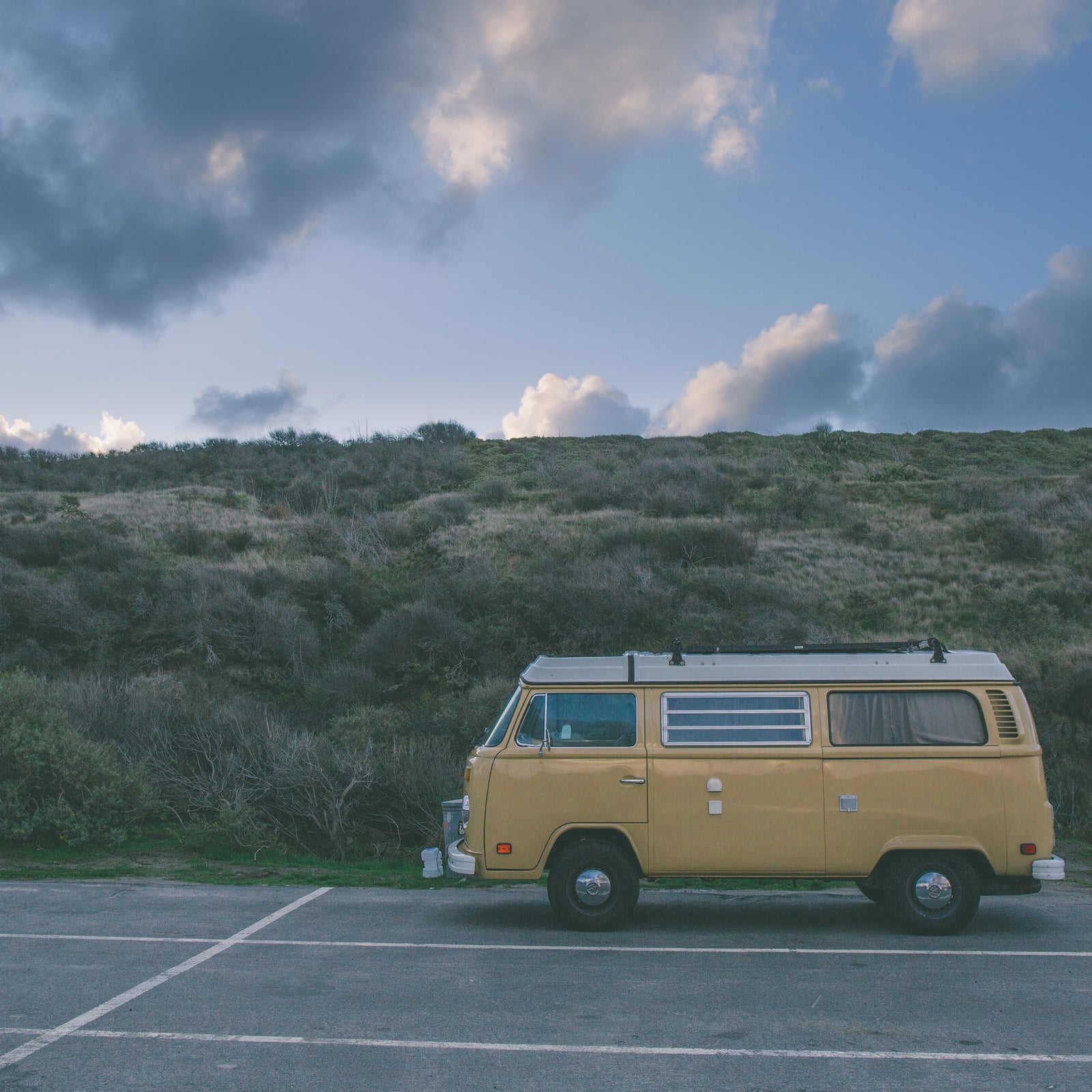The first thing outdoor photographer James Barkman () did after buying his bright��orange 1976 Volkswagen Westfalia was drive it across the country. Since then��he’s roamed widely in what he affectionately calls the Yellow Submarine. He spends the majority of his time in the western U.S., surfing, climbing, and snowboarding, but he’s driven as far north as Tofino, British��Columbia, and 500 miles south of the U.S. border into Mexico. “I never keep track of miles,” he says. Instead, he counts the number of times he has replaced the van’s motor. (He’s on number five.) Recently, Barkman purchased a military-surplus periscope for the bus, to complete the submarine look. He plans to mount the device so it can poke out of the ceiling and swivel. “It would be super sick if I could do it right above the driver’s seat, and then I could bring it down and look through it,” he says.
Barkman has now lived in his camper van for seven years. Along the way, he’s learned a few things about how to road-trip.��“You hit the road, and you never know how that might connect you with people that will change your life,” he says. Here are nine��tips he’s picked up along the way that will help you maximize your travel time, whether it’s over��a weekend or much longer.
Read before you go.
Recently, Barkman drove through Wyoming for the first time. “I stopped at this classic interstate truck diner, which is my favorite thing in the world,” he says. A side trip to a hot spring later refreshed his mind and body after long hours of driving.
While it’s possible to stumble upon these surprises, Barkman likes to research his destinations��and the places en route��ahead of time. “I think there’s no substitute for just diving into information on the web and reading everything you can find,” he says. For a trip through New England, Barkman poured over paper maps and atlases��and circled small coastal towns and parks he wanted to visit. Then he read everything he could about the area online��before he arrived. The payoff included small-town farmers’ markets, mountain views, and lakeside campsites. He also found��a local fisherman who sold him freshly caught lobsters straight off the boat.
It’s easy to get caught up in counting down the miles or to become dazed from the interstate and miss that great little��restaurant tucked down the road. Researching ahead of time helps ensure you get the goods. “Spending time always pays off,” Barkman says. “You end up experiencing these things that you remember forever.”
Move your maps offline.��
Google Maps has become the go-to for most of us when it comes to��finding everything from campsites to coffee shops. It’s all good until suddenly you don’t have cell service. “Whenever I’m going somewhere I think there won’t be service, I download the whole zone from Google Maps to use offline,” says Barkman. () File sizes for larger maps can be more than a gigabyte, so make sure you have enough storage space on your phone.
has become the app Barkman relies on most for both topographical and street-level mapping. You can download a bigger area than through Google Maps, and while the maps are typically less detailed, Barkman says they offer��the basics and download more quickly over a cell signal. It’s also clutch for importing GPS routes to follow. “I did this big moto trip through Nevada and eastern��Oregon, and the whole time we were away from any sort of town,” he says. “There were so many trails and forest roads, and we just imported a GPS route and followed it turn��by��turn.” The app also provides��fairly accurate route times for hiking and climbing, he says.
If every contour line matters,����and����offer detailed topographical maps, and both apps allow you to download map sectors for offline use. Because they provide a more granular view, and thus require more data, Barkman recommends downloading them on a Wi-Fi��connection. (Both services��also require a paid subscription for offline use—CalTopo��starts at $20 per year; OnX, $30 per year.)
Your phone is the best hot spot.
For working on the road, Barkman simply uses the hot spot on his smartphone.“I’ve never owned another hot spot for day-to-day use,” he says. “My phone has plenty of data for most things I need to do.” (He uses T-Mobile��and is happy with the coverage.)
When he needs a Wi-Fi connection to send or receive bigger files, Barkman heads to Starbucks. “For me and for other nomadic nerds, Starbucks is always the call, because there’s always one��nearby and��they always have good free Wi-Fi.” Most McDonald’s locations offer free Wi-Fi, too.
Barkman does carry a satellite hot spot for emergencies when he’s in more remote areas. He uses , a subscription-based service��that��doesn’t provide a full-service internet connection��but which, when paired with a smartphone, enables the user to send text messages anywhere within the U.S. or Canada��or email��to any address in the world. “So, say, if I break down somewhere in the middle of nowhere or there’s an emergency, people can always contact me, and I can always contact them,” Barkman says. (Recently, he ran out of oil in a remote spot in Oregon��and was able to message a friend to bring some.) The hot spot, which includes a built-in SOS beacon, costs��$280, and subscriptions range from $8.33 a month for eight satellite messages��to $50 per month for unlimited messaging.
Talk to strangers.
As he travels, Barkman likes to chat up the people he meets. Often��they lead him to the most unforgettable experiences. While he meets folks��just about everywhere he goes, he says, like-minded people tend to flock to the same places he does: bars, restaurants, ski-resort parking lots, and trailheads.
Starting conversations with strangers doesn’t come naturally to everyone, so Barkman says two easy ways to break the ice are to seek out common ground and listen to others’ stories. Being a good listener can open a lot of doors, he says. But don’t overthink it.��“Just be yourself and be confident,” he says.��Remember that you have more to gain than to lose, and��putting yourself out there to start a side conversation might well yield an unexpected and memorable adventure. Barkman met one of his best friends at a gas pump. “We were filling gas, and he was there in a van with his girlfriend, and we planned to meet up in Joshua Tree and camp together,” he remembers.
Look for a park and��ride.��
With his spontaneous approach to travel, Barkman sometimes ends up nowhere near his intended destination when he’s ready to park for the night. The trick to overnighting in areas that aren’t designated for camping, or where camping isn’t allowed, is to keep a low profile, he says. “I close all the blinds, and I try to be careful with the lights.” His clutch camping spot: park-and-ride lots. They’re easy to find through an online search, and he’s never run into trouble there with a quick��overnight stay.
Become a burrito connoisseur.
Easy meals that don’t require intensive clean-up are the clear choice for life on the road. “I don’t care what it is, as long as I don’t have to do dishes,” says Barkman. His Westfalia does have a sink; he just prefers not to use it: “It’s small and annoying.”
So think sandwiches, burritos, or, if you want to get fancy, avocado toast. “I’m a big burrito guy,” says Barkman. His go-to ingredients include beans, avocado, eggs, and meat,��typically wild game. During hunting season, he stocks up on game such as venison and elk to eat throughout the year. He made his best-ever burrito in Alaska��from eggs, cheese, cilantro, and freshly��caught salmon. “It was salmon we pulled out of the ocean—as fresh as you can get,” he recalls.
Stay warm.
In cold conditions, Barkman stays cozy with a��diesel heater. He had a woodstove in the past, but it took up more space and didn’t heat his van as efficiently.��“You can get them from Amazon for like 100 to 150 bucks, and they totally crank,” he says.��He prefers the dry heat of diesel to propane.��“If you crank a propane heater in your rig, you just have condensation everywhere.��Diesel will really dry everything out,” he says. And that’s��a nice side benefit: you can slide into a dry wetsuit for tomorrow’s dawn patrol��or into warm pants for your snowboard session. Venting the diesel heater is key—Barkman cut a hole in the floor of his van and runs the heater’s exhaust out of it.
Invest in good tires.
Digging your van out of the sand makes for a good story, but choosing tires that’ll work for a variety of conditions will ensure that your tales are more about the killer places you’ve been than the mishaps along the way. The Yellow Submarine rolls on General Grabber AT2 tires. “They do great on the highway, and they’re really capable in sand, mud, and snow,” he says. “I can go to the snow in the morning and back to the coast in the afternoon.”
Stay a step ahead of thieves.
When he’s on the road, Barkman finds it reassuring to have a safe place to stash camera equipment, hard drives, and essential documents like his passport. “People notice vans and know that there are valuable things inside,” he says. “Break-ins happen more than ever.” Beach parking lots and popular trailheads in particular can be a magnet for thieves.
Besides keeping valuables out of sight, Barkman recommends a safe or lockbox for the really important stuff. There are many options readily available online, and you’ll want something that’s designed for the make and model of your vehicle. Barkman ordered his safe from Dave Harrison (), who makes custom��lockboxes for vehicles including��VW buses, Sprinters, and Ford Transit Connects. “I can leave my rig in a place that’s maybe a little sketchy and be fully confident that no one can break into the safe,”��he says. When Barkman recently parked the Yellow Submarine at the Seattle airport, he returned to a smashed window and $4,000 worth of stolen gear. The essentials stored in his safe, though, remained undisturbed.


